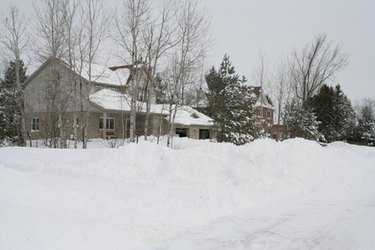Things You'll Need
Wire brush
Wrench
Screwdriver set
Jumper wire for relay test
Battery meter/charger

No matter what type of snow plow you're using to clear your property or make a winter's living, ensuring good maintenance and functionality is imperative. Early morning at the height of a snowstorm is not the time to do it. If your plow is showing signs of wear or malfunction, you can take steps to keep it from failing when you need it most.
Step 1
Check for power problems. If the motor isn't allowing you to engage the plow, the problem could be with the battery or its connection, the motor itself, a blown fuse or an issue with your controller.
Disconnect the negative and then positive leads of your battery. Clean your battery leads and posts with a wire brush and fill the water cells to your battery's specifications. Inspect the wiring and reconnect the battery, including the lead for your plow -- first all positive wiring, then the negative ground. Verify that your battery has a full charge with a battery meter/charger.
Do a relay test to isolate the part of the power system that may need replacement. Disconnect your lift chain and any hoses connected to your motor. Locate your motor relay near the battery, where the positive lead from your battery attaches to a mechanism to divert power for your plow motor. Connect a jumper wire from the small terminal where the black wire is attached to your relay to the negative terminal of your battery. Confirm that the negative lead on your relay is properly grounded and see if you get power by turning your ignition on and engaging your plow controller.
Turn off the vehicle, then connect the jumper wire to the positive post of the battery and the other end to the small terminal on the relay with the red wire attached. Try operating the control again in raise, left and right modes. Try using the jumper to connect past the large terminals at the top of the relay and attaching directly to the smaller terminals. If you get power, you may need a new relay. Ensure that all bolts and screws on the motor are tightened. If you're convinced your battery isn't to blame, it may be time for a new plow motor.
Step 2
Verify that your motor is working and not damaged. After you've established that power isn't the problem, ensure that the hydraulic fluid container is full and that the type of fluid you're using aligns with manufacturer's specifications (the cap is usually at the base of the motor, where it connects to the bottom hydraulic unit). Inspect the bottom of the motor mechanism, the hydraulic pump and all tubing for excessive dripping or visible damage. See where any leaks are coming from, and tighten down all bolts -- especially the top mount where the power cable is bolted down. A leak around a hose connection could mean a blown and easy-to-replace seal -- or the need for a full-blown parts replacement. Consult your parts diagram at your manufacturer's website to order replacement parts.
Step 3
Inspect the snow plow's connection with your front bumper's mount and A-frame, especially if you're experiencing controller issues. Tighten all bolts and hitch pins in the frame, and confirm that the spring is attached and operational between the front quadrant frame and the back of the blade mechanism. Remove any snow or ice from the frame that may be impeding the motor's operation. If your motor is still not powered on, replace the hydraulic pump filter and flush the system according to your manufacturer's specifications.
Step 4
Check the blade and controller operation if your motor is operational but not functioning correctly. Place the blade on the ground in the neutral position with your cab controller. Move it up levelly, then down to ground level again. Place it in mid-high elevation, then tilt it left or right by pressing the controller to the left or right, respectively. Inspect the covering at the bottom of the blade. Ensure that it's not excessively damaged.
Step 5
Fine-tune your controller and cabling operations. Correct faulty angling by adjusting the cushion valves with a screwdriver on the hydraulic pump, usually below the motor on the side of the pump. Fix angling and elevation speed by adjusting the "jam nut" at the base of the controller handle. Turn the nut counterclockwise to increase left-angling speed and clockwise to increase right-angling speed. Adjust the lift and check valves with screws on either side of the pump.
Tip
Consult your specific manufacturer's manual for identifying parts and parts numbers for replacement.
Warning
Disconnect the negative lead to your battery whenever testing your battery system.